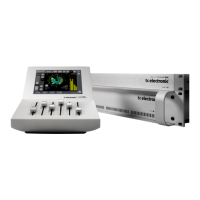107
bACkDrOP - TuTOrIAl
controls and to listen to the amount of noise reduction,
the occurrence of musical noise, and the smearing of
transients (signal distortion). These variables must be
balancedwhenusingBackDroptoremovenoisefrom
youraudio.Fortunately,BackDropprovidesyouwitha
comprehensivesetoftoolstomaketheoptimalpossible
trade-off.
WhenusingBackDrop’scontrolsitisimportantto
rememberthatAggressionandMaxReductionwork
togetherandsoyoushouldgobackandforthbetween
these parameters in order to find the best settings. This
also applies to the Basilar Dispersion and Transient
Recoverycontrolswhichworktogether.
Advanced Use
The tutorial in the previous section was intended to give
youafeelforsomeofBackDrop’scontrols.Inthissection
we endeavor to provide you with some guidelines for
obtainingthebestpossibleperformancefromBackDrop.
The following steps have been found to be a suitable
approach for getting good performance under almost
all circumstances. As you become more familiar with
BackDropyouwillnodoubtdevelopyourowntechniques
andstrategiesthatworkbestforyou.
As always, the first step in the noise reduction process
is to capture a sample of the audio for the noise print
information. It is very important that the audio used to
calculate the noise print information contain only the noise
and none of the signal.
With the noise print information calculated, use the
AlgorithmModelcontroltoselecttheBackDropalgorithm
(Basic, MultiBand or MultiType) that is best suited to the
noise you are trying to remove.
BackDrop’sfundamentalphilosophyistotargetthenoise
reduction to where it is needed most and to apply as little
processing as possible to the signal. The strategy outlined
inthissectionisinkeepingwiththisphilosophy.Generally
speaking,togetthebestresultsfromBackDrop,donot
be“overaggressive”.Trytouseaslowanamountof
aggression, and Max Reduction as possible, and use a
moderate amount of Basilar Dispersion (40% to 60%).
It is useful to begin by getting an idea of how much noise
reduction is necessary for the audio sequence that you
areworkingon.Inmanycasesreducingthenoisebyonly
afewdecibelswillmakeadramaticimprovementinthe
quality of the audio sequence. In most cases, you will
not need more than about 10 dB of noise reduction. To
determine how much noise reduction is necessary, set
Basilar Dispersion and Transient Recovery to 0%. Set
Aggression to 100% and Max Reduction to 0 dB. Slowly
increase Max Reduction and listen as the level of noise
goesdown.UsetheBypassbuttontoturntheprocessing
onandoff.AdjustMaxReductionuntilyouobtainthe
appropriate amount of noise reduction.
With Aggression set to 100%, you are probably applying
more processing than necessary for the amount of noise
reduction that you desire. Therefore, slowly lower the
amount of Aggression until you here the level of the
noise floor begin to increase. This level of Aggression
corresponds roughly to the amount of reduction that you
desire and the value of Max Reduction that you have
selected. Note that this relation between Aggression and
Max Reduction depends on the signal being processed and
so the relative settings will be different for different audio
sequences.
ItisnowagoodtimetomonitorBackDrop’soutputvery
carefully and decide the following:
Isthistoomuchnoisereduction?Oftenitisdesirable
toleavesomebackgroundnoiseinthesignalsothatit
doesn’tsoundunnaturallyclean.Thisisprimarilytruefor
anoverallmixedsignalratherthanforindividualtracksthat
are yet to be mixed together.
Doyouhearanyartifacts?Ifyouhearartifactsthen
increase the amount of Basilar Dispersion until the level
of the artifacts becomes acceptable or the artifacts
becomes completely inaudible. In some cases, increasing
the amount of Aggression slightly when applying Basilar
Dispersion can also reduce the artifacts. You can also
takeadvantageofsomeoftheresidualhisstomask
artifacts created by the process itself. By using a little less
noise reduction and aggression, leaving a small amount
of residual hiss, you will have a harder time hearing any
artifacts.
Arethetransients(attacks)beingsmeared?Ifincreasing
the amount of Basilar Dispersion has caused a smearing
of the transients then you may want to increase the level of
Transient Recovery. It should be noted that higher levels of
Transient Recovery can cause some of the musical noise
to reappear. Therefore, Basilar Dispersion and Transient
Recoveryneedtobeadjustedtogetherinordertominimize
both the musical noise and the smearing of transients.
Are you losing the sound quality or clarity of the original
source?Itiseasytobecomeveryfocussedonthetaskof
removingnoiseandoverlookthefactthatthesignalhas
become somewhat distorted (altered). Remember to listen
tothesignalaswellasthenoise.Youwillneedtostrikea
balance between the amount of noise reduction possible
and the effect on the sound quality of the music. Keep in
mindthatBackDropwasspecificallydesignedtoenable
youtomakethebestpossibletrade-offforyourapplication.
You should be aware that when removing noise it is
commontouncoverlow-levelsoundsthatyoumightthink
areartifactsresultingfromBackDrop.Frequentlythese
sounds are actually part of the original signal but they were
partiallyhiddenbythenoise.UsetheBypassbuttonto
compare the processed signal to the original signal to see
if the sound was actually part of the original.
Whilekeepingtheabovepointsinmind,youshouldgo
backandforthbetweenthevariouscontrolsandadjust
them until the optimal noise reduction solution is reached.
Ofcourse,youshouldtryallthreeofBackDrop’salgorithm
modelstodeterminewhichoneisbestsuitedforthetask
at hand. Remember that you can switch instantly between
the algorithm models and the settings for each model are

